Landslide classification
There have been known various classifications of landslides and other types of mass wasting.
For example, the McGraw-Hill Encyclopedia of Science and Technology distinguishes the following types of landslides:
- fall (by undercutting)
- fall (by toppling)
- slump
- rockslide
- earthflow
- rockslide that develops into rock avalanche
The used classification factors
Various scientific disciplines have developed taxonomic classification systems to describe natural phenomena or individuals, like for example, plants or animals. These systems are based on specific characteristics like shape of organs or nature of reproduction. Differently, in landslide classification, there are great difficulties due to the fact that phenomena are not perfectly repeatable; usually being characterised by different causes, movements and morphology, and involving genetically different material. For this reason, landslide classifications are based on different discriminating factors, sometimes very subjective. In the following factors are discussed by dividing them into two groups: the first one is made up of the criteria utilised in the most widespread classification systems that can generally be easily determined. The second one is formed by those factors that have been utilised in some classifications and can be useful in descriptions
A1) Type of movement
This is the most important criteria, even if uncertainties and difficulties can arise in the identification of movements, being the mechanisms of some landslides often particularly complex. The main movements are falls, slides and flows, but usually topples, lateral spreading and complex movements are added to these. They can be deadly.
A2) Involved material
Rock, earth and debris are the terms generally used to distinguish the materials involved in the landslide process. For example, the distinction between earth and debris is usually made by comparing the percentage of coarse grain size fractions. If the weight of the particles with a diameter greater than 2 mm is less than 20%, the material will be defined as earth; in the opposite case, it is debris.
A3) Activity
The classification of a landslide based on its activity is particularly relevant in the evaluation of future events. The recommendations of the WP/WLI (1993) define the concept of activity with reference to the spatial and temporal conditions, defining the state,

the distribution and the style. The first term describes the information regarding the time in which the movement took place, permitting information to be available on future evolution, the second term describes, in a general way, where the landslide is moving and the third term indicates how it is moving.
A4) Movement velocity
This factor has a great importance in the hazard evaluation. A velocity range is connected to the different type of landslides, on the basis of observation of case history or site observations.
B1) The age of the movement
Landslide dating is an interesting topic in the evaluation of hazard. The knowledge of the Landslide frequency is a fundamental element for any kind of probabilistic evaluation. Furthermore, the evaluation of the age of the landslide permits to correlate the trigger to specific conditions, as earthquakes or periods of intense rains. It should be noted that, it is possible that phenomena could be occurred in past geological times, under specific environmental conditions which no longer act as agents today. For example, in some Alpine areas, landslides of the Pleistocene age are connected with particular tectonic, geomorphological and climatic conditions.
B2) Geological conditions
This represent a fundamental factor of the morphological evolution of a slope. Bedding attitude and the presence of discontinuities or faults control the slope morphogenesis.
B3) Morphological characteristics
As the landslide is a geological volume with a hidden side, morphological characteristics are extremely important in the reconstruction of the technical model.
B4) Geographical location
This criterion describes, in a general way, the location of landsides in the physiographic context of the area. Some authors have therefore identified landslides according to their geographical position so that it is possible to describe "alpine landslides", "landslides in plains", "hilly landslides" or "cliff landslides". As a consequence, specific morphological contexts are referred characterised by slope evolution processes.
B5) Topographical criteria
With these criteria, landslides can be identified with a system similar to that of the denomination of formations. Consequently, it is possible to describe a landslide using the name of a site. In particular, the name will be that of the locality where the landslide happened with a specific characteristic type.
B6) Type of climate
These criteria give particular importance to climate in the genesis of phenomena for which similar geological conditions can, in different climatic conditions, lead to totally different morphological evolution. As a consequence, in the description of a landslide, it can be interesting to understand in what type of climate the event occurred.
B7) Causes of the movements
In the evaluation of landslide susceptibility, causes of the triggers is an important step. Terzaghi describes causes as "internal" and "external" referring to modifications in the conditions of the stability of the bodies. Whilst the internal causes induce modifications in the material itself which decrease its resistance to shear stress, the external causes generally induce an increase of shear stress, so that block or bodies are no longer stable. The triggering causes induce the movement of the mass. Predisposition to movement due to control factors is determining in landslide evolution. Structural and geological factors, as already described, can determine the development of the movement, inducing the presence of mass in kinematic freedom.
Types and classification
In the following table shows a schematic landslide classification adopting the classification of Varnes 1978 and taking into account the modifications made by Cruden and Varnes, in 1996. Some integration has been made by using the definitions of Hutchinson (1988) and Hungr et al. 2001.
| Type of movement | Type of material | ||||
| Bedrock | Engineering soils | ||||
| Predominantly fine | Predominantly coarse | ||||
| Falls | Rockfall | Earth fall | Debris fall | ||
| Topples | Rock topple | Earth topple | Debris topple | ||
| Slides | Rotational | Rock slump | Earth slump | Debris slump | |
| Translational | Few units | Rock block slide | Earth block slide | Debris block slide | |
| Many units | Rock slide | Earth slide | Debris slide | ||
| Lateral spreads | Rock spread | Earth spread | Debris spread | ||
| Flows | Rock flow | Earth flow | Debris flow | ||
| Rock avalanche | Debris avalanche | ||||
| (Deep creep) | (Soil creep) | ||||
| Complex and compound | Combination in time and/or space of two or more principal types of movement | ||||
Falls
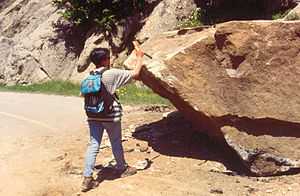
Description: "A fall starts with the detachment of soil or rock from a steep slope along a surface on which little or no shear displacement takes place. The material then descends mainly through the air by falling, bouncing, or rolling" (Varnes, 1996).
Secondary falls: "Secondary falls involves rock bodies already physically detached from cliff and merely lodged upon it" (Hutchinson, 1988)
Speed: from very to extremely rapid
Type of slope: slope angle 45-90 degrees
Control factor: Discontinuities
Causes: Vibration, undercutting, differential weathering, excavation, or stream erosion
Topples

Description: "Toppling is the forward rotation out of the slope of a mass of soil or rock about a point or axis below the centre of gravity of the displaced mass. Toppling is sometimes driven by gravity exerted by material upslope of the displaced mass and sometimes by water or ice in cracks in the mass" (Varnes, 1996)
Speed: extremely slow to extremely rapid
Type of slope: slope angle 45-90 degrees
Control factor: Discontinuities, lithostratigraphy
Causes: Vibration, undercutting, differential weathering, excavation, or stream erosion
Slides
"A slide is a downslope movement of soil or rock mass occurring dominantly on the surface of rupture or on relatively thin zones of intense shear strain." (Varnes, 1996)

Translational slide
Description: "In translational slides the mass displaces along a planar or undulating surface of rupture, sliding out over the original ground surface." (Varnes, 1996)
Speed: extremely slow to extremely rapid (>5 m/s)
Type of slope: slope angle 45-90 degrees
Control factor: Discontinuities, geological setting
Causes: Vibration, undercutting, differential weathering, excavation, or stream erosion
Rotational slides
Description: "Rotational slides move along a surface of rupture that is curved and concave" (Varnes, 1996)
Speed: extremely slow to extremely rapid
Type of slope: slope angle 45-90 degrees
Control factor: morphology and lithology
Causes: Vibration, undercutting, differential weathering, excavation, or stream erosion
Spreads
Description: "Spread is defined as an extension of a cohesive soil or rock mass combined with a general subsidence of the fractured mass of cohesive material into softer underlying material." (Varnes, 1996). "In spread, the dominant mode of movement is lateral extension accommodated by shear or tensile fractures" (Varnes, 1978)
Speed: extremely slow to extremely rapid (>5 m/s)
Type of slope: angle 45-90 degrees
Control factor: Discontinuities, lithostratigraphy
Causes: Vibration, undercutting, differential weathering, excavation, or stream erosion
Flows
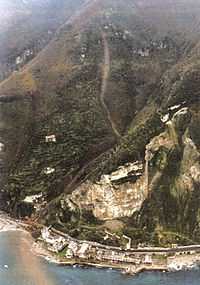
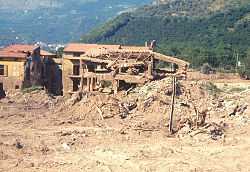
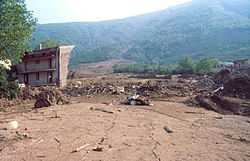
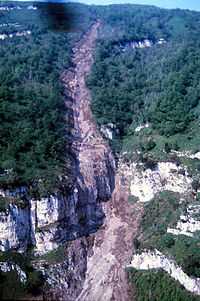
A flow is a spatially continuous movement in which surfaces of shear are short-lived, closely spaced, and usually not preserved. The distribution of velocities in the displacing mass resembles that in a viscous liquid. The lower boundary of displaced mass may be a surface along which appreciable differential movement has taken place or a thick zone of distributed shear (Cruden & Varnes, 1996)
Flows in rock
Rock Flow
Description: "Flow movements in bedrock include deformations that are distributed among many large or small fractures, or even microfracture, without concentration of displacement along a through-going fracture" (Varnes, 1978)
Speed: extremely slow
Type of slope: angle 45-90 degrees
Causes: Vibration, undercutting, differential weathering, excavation, or stream erosion
Rock avalanche (Sturzstrom)
Description: "Extremely rapid, massive, flow-like motion of fragmented rock from a large rock slide or rock fall” (Hungr, 2001)
Speed: extremely rapid
Type of slope: angle 45-90 degrees
Control factor: Discontinuities, lithostratigraphy
Causes: Vibration, undercutting, differential weathering, excavation or stream erosion
Flows in soil
Debris flow
Description: "Debris flow is a very rapid to extremely rapid flow of saturated non-plastic debris in a steep channel" (Hungr et al.,2001)
Speed: very rapid to extremely rapid (>5 m/s)
Type of slope: angle 20-45 degrees
Control factor: torrent sediments, water flows
Causes: High intensity rainfall
Debris avalanche
Description: "Debris avalanche is a very rapid to extremely rapid shallow flow of partially or fully saturated debris on a steep slope, without confinement in an established channel." (Hungr et al., 2001)
Speed: very rapid to extremely rapid (>5 m/s)
Type of slope: angle 20-45 degrees
Control factor: morphology, regolith
Causes: High intensity rainfalls

Earth flow
Description: "Earth flow is a rapid or slower, intermittent flow-like movement of plastic, clayey earth." (Hungr et al.,2001)
Speed: slow to rapid (>1.8 m/h)
Type of slope: slope angle 5-25 degrees
Control factor: lithology
Mudflow
Description: "Mudflow is a very rapid to extremely rapid flow of saturated plastic debris in a channel, involving significantly greater water content relative to the source material (Plasticity index> 5%)." (Hungr et al.,2001)
Speed: very rapid to extremely rapid (>5 m/s)
Type of slope: angle 20-45 degrees
Control factor: torrent sediments, water flows
Causes: High intensity rainfall
Complex movement
Description: Complex movement is a combination of falls, topples, slides, spreads and flows
See also
- Landslide
- Landslide Mitigation
- Causes of landslides
References
- Caine, N., 1980. The rainfall intensity-duration control of shallow landslides and debris flows. Geografiska Annaler, 62A, 23-27.
- COATES, D. R. (1977) - Landslide prospectives. In: Landslides (D.R. Coates, Ed.) Geological Society of America, pp. 3–38.
- Corominas, J. and Moya, J. 1999. Reconstructing recent landslide activity in relation to rainfall in the Llobregat River basin, Eastern Pyrenees, Spain. Geomorphology, 30, 79-93.
- Cruden D.M., VARNES D. J. (1996) - Landslide types and processes. In: Turner A.K.; Shuster R.L. (eds) Landslides: Investigation and Mitigation. Transp Res Board, Spec Rep 247, pp 36–75.
- Hungr O, Evans SG, Bovis M, and Hutchinson JN (2001) Review of the classification of landslides of the flow type. Environmental and Engineering Geoscience, VII, 221-238.
- Hutchinson J. N.: Mass Movement. In: The Encyclopedia of Geomorphology (Fairbridge, R.W., ed.), Reinhold Book Corp., New York, pp. 688–696, 1968.
- Harpe C. F. S.: Landslides and related phenomena. A Study of Mass Movements of Soil and Rock. Columbia Univo Press, New York, 137 pp., 1938.
- Keefer, D.K. (1984) Landslides caused by earthquakes. Bulletin of the Geological Society of America 95, 406-421.
- Varnes D. J.: Slope movement types and processes. In: Schuster R. L. & Krizek R. J. Ed., Landslides, analysis and control. Transportation Research Board Sp. Rep. No. 176, Nat. Acad. oi Sciences, pp. 11–33, 1978.
- Terzaghi K. - Mechanism of Landslides. In Engineering Geology (Berkel) Volume. Ed. da The Geological Society of America~ New York, 1950.
- WP/ WLI. 1993. A suggested method for describing the activity of a landslide. Bulletin of the International Association of Engineering Geology, No. 47, 53-57.